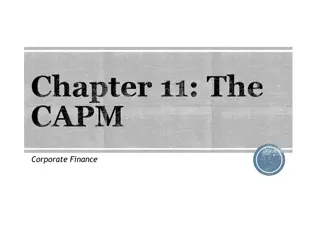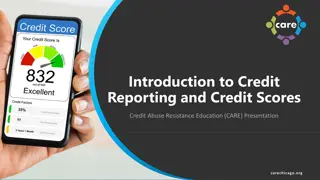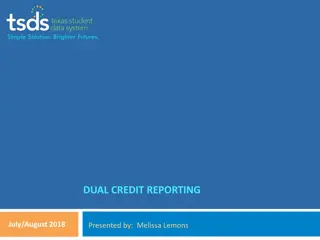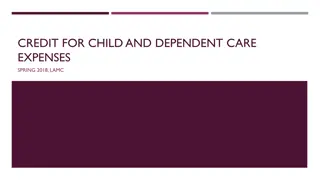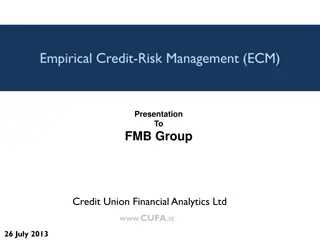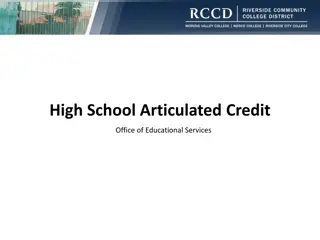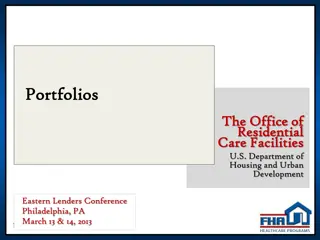
Banking and Credit Industry Insights: 2024 Trends and Failures
Explore the current landscape of the banking and credit industry in 2024, including economic uncertainty, high interest rates, and challenges faced by banks. Discover the factors contributing to historical and recent bank failures, liquidity concerns, and risks in credit/investment losses. Learn from past events like the Great Recession and understand how banks can face critical situations when they fail to meet their obligations.
Download Presentation

Please find below an Image/Link to download the presentation.
The content on the website is provided AS IS for your information and personal use only. It may not be sold, licensed, or shared on other websites without obtaining consent from the author. If you encounter any issues during the download, it is possible that the publisher has removed the file from their server.
You are allowed to download the files provided on this website for personal or commercial use, subject to the condition that they are used lawfully. All files are the property of their respective owners.
The content on the website is provided AS IS for your information and personal use only. It may not be sold, licensed, or shared on other websites without obtaining consent from the author.
E N D
Presentation Transcript
Credit Portfolio Management Kevin Futrell Lead Credit Officer Synovus Bank
Course Overview Banking/Credit Industry Update Historical Bank Failures Strategic Portfolio Management Tactical Portfolio Management Review Home Study Overview
Banking/Credit Industry in 2024 Economic uncertainty and high interest rates are resulting in modest loan growth Net Interest Margin remains compressed as banks fight to maintain/attract deposits Loan to Deposit Ratios are rising Credit quality remains strong but has weakened as increased interest rates and inflation have taking a toll on some businesses Refinance Risk is significant, particularly in the Commercial Real Estate sector
Banking/Credit Industry in 2024 Access to Liquidity remains a focus for the industry Sources include: FED funds, FED discount window, Federal Home Loan Bank, Securities Portfolio and 3rdparty debt
Credit/investment losses erode the banks capital position Runs on deposits erode the bank s liquidity position WHY DO BANKS FAIL? In short, the bank cannot meet its obligations
Silicon Valley Bank Signature Bank Republic First RECENT BANK FAILURES
Economy contracts Real estate values drop Prices fall Credit losses mount HISORICAL BANK FAILURES
WHAT ABOUT THE GREAT RECESSION ? LEADING UP TO IT .. Long period of economic growth Stable interest rate environment post 9/11 Housing boom Relaxed underwriting (sub-prime and adjustable rates)
THEN BOOM! IT HAPPENED Interest rates rise to combat inflation Mortgage payments rise and homeowners beginning selling Housing market collapses Banks are heavily invested in housing on both the credit side and the investment side (mortgage backed securities) 527 Bank failures WHAT ABOUT THE GREAT RECESSION ?
What leads up to credit losses so catastrophic? TWO PRIMARY DRIVERS .. Credit Process Concentrations
What does the Credit Process include? Five Essential Components Credit risk policy Credit underwriting process Credit approval process Credit measurement and monitoring process Credit oversight and controls
What are some weaknesses in the Credit Process? Inadequate financial analysis Inadequate industry analysis Inadequate downside analysis Liberal lending authorities Ineffective credit review process Poor documentation Speculative purpose loans Liberal repayment terms High loan to value Low debt service coverage Weak, non-existent covenants
What constitutes a Concentration? Credit exposure where potential losses are large relative to the bank s capital position and/or the overall loan portfolio
What are some types of Concentrations? Industry Commercial Real Estate Product Types Geography Borrower
How can Credit Portfolio Management Reduce the Impact of Market Driven Credit Problems? Strategic Credit Portfolio Management Tactical Credit Portfolio Management
Strategic Credit Portfolio Management should have the following well defined Responsibility for reviewing, approving and implementing credit risk strategies and policies Credit approval criteria to include analysis and understanding of borrower, market conditions, loan purpose and repayment of funds Credit approval process to include approval authority levels for types and sizes of loans along with policy exceptions
Strategic Credit Portfolio Management should have the following well defined Credit limits for borrowing relationships (house verse legal lending limits) and how to manage exceptions System for assigning internal risk ratings Process for on-going monitoring of credits based on size and/or complexity
But wait, theres more! Information systems and analytics for monitoring the composition and quality of the portfolio On-going Credit Review function operating independently of the Credit Approval function System of managing problem credits and workout situations
Lets move on to Tactical Credit Portfolio Management
Focuses on 3 areas at the loan transaction level Credit Underwriting Credit Monitoring Exception Tracking What is Tactical Management of the Credit Portfolio? All with the common goal of preventing problem loans
Account Officer Level simply monitoring and measuring individual loans in accordance with the terms and conditions of approval How it is measured? Credit Portfolio Level aggregately monitoring and measuring exceptions related to individual loans with the collective credit portfolio
An ounce of prevention is worth a pound of cure It all begins with underwriting Ben Franklin, 1735
Have you done business with them? Was it satisfactory? Do they have a good reputation? Is this their primary business? Is management capable? Are they local? Underwriting Considerations Know your borrower and guarantors
Underwriting Considerations How cyclical is the industry? What is the current stage/state of the industry? Have they successfully experienced economic downturns? What is the competitive landscape? Consider Economic Conditions and Industry
Underwriting Considerations How much historical data is needed? 1, 3, 5 years? When should projections be prepared? How much guarantor information is needed? How much information is required for the related interests of the borrower and guarantors? Obtain current and sufficient financial information
What is the valuation source? Have you visited the collateral? Is it in your market area? Can you perfect your interest in the collateral? Is loan to value within policy? Is it easily liquidated? Underwriting Considerations Know your collateral
Do the repayment terms match the collateral? Do the repayment terms match the purpose? Do the loan covenants pertain to the key credit risks? Does the structure fall within policy? Underwriting Considerations Loan Structuring
Loan Closing Considerations Is outside counsel required? Is a loan agreement required? Who is responsible for collateral perfection? Loan Documentation
Monitoring Considerations What types of reporting? How frequently? What quality? Is financial reporting within policy? Financial Reporting
What dollar level? How frequently? How extensive? Covenant compliance? Discuss financial results with the borrower? Monitoring Considerations Credit Review
What is it? The impact on upcoming loan maturities (up to 24 months out) based on the interest rate at renewal verses the current interest rate. Why is it important? Monitoring Considerations Impacts the ability of the borrower to repay the loan, thereby creating a credit quality weakness. Commercial Real Estate is experiencing the most impact What are the options? Refinance Risk Right-size the loan through paydown Extend the amortization
My borrower has overdrafts and runs past due on their payments but the financial numbers look good! Common Credit Thoughts Bad Behaviors outweigh Good Numbers
My borrower has never missed a payment but their financials don t look very good! Common Credit Thoughts Bad Numbers outweigh Good Behaviors
Tell someone!!!! What do I do when I discover an issue with a credit? A Raised Hand is better than a Buried Head
Exception Tracking What exceptions should be tracked? Financial Statement Exceptions Credit Review Exceptions Borrowing Base Exceptions Loan Covenant Compliance Exceptions Policy Exceptions Loan Documentation Exceptions
Financial Statement Exception Tracking What are Financial Statement requirements? Agreement that the borrower and/or guarantor will provide on-going financial information to assess the performance of the credit during the lifeofthe credit. When should exceptions be noted? What is an acceptable level of exceptions?
Credit Review Exception Tracking What are Credit Reviews? Periodic assessment to determine whether the credit is performing as expected. Essentially, it is a modified re- underwrite of the credit. When are exceptions noted? What is an acceptable level of exceptions?
Borrowing Base Exception Tracking What is a Borrowing Base report? Essentially, a periodic collateral analysis for working capital lines of credit that are secured with Accounts Receivable and Inventory. Credit availability is adjusted based on advance rates for each type of collateral. Reporting requirements? Grace period? Supporting documentation? Out of date? How long? How frequently? Out of monetary compliance? How long? How frequently? Should credit be moved to an asset-based lender or factoring company?
Loan Covenant Compliance Exception Tracking What are Loan Covenants? Simply put, they are financial and non-financial expectations for the borrower to remain in good standing with bank Reporting requirements? Out of date? How long? Out of compliance? How frequently? Should violation be waived? Fee charged? Should reservation of rights letter be issued?
Policy Exception Tracking What are Policy Exceptions? Deviations (approved or not approved) from loan policy Which exceptions should be tracked? Regulatory Loan-to-value limits for real estate Loan-to-value, Loan-to-costs, Equity Amortization, Maturity Debt Service Coverage Guarantor
Policy Exception Tracking How long should exceptions be reported? -12 months? -18 months? -Life of the loan? What is an acceptable level of exceptions?
Loan Documentation Exception Tracking What are Loan Documentation Exceptions? Deviations from standard loan closing requirements that could potentially impact the enforceability of the loan documents Categories of Documentation Exceptions Account/Note Level Note, Loan Agreement, etc Collateral Level Mortgage, UCC, Title, etc Guarantor Level Full, Limited, Burn off, etc
Loan Documentation Exception Tracking Should all documentation exceptions carry equal weight? Of course not! Generally, those which have the greatest impact on collection carry the most weight
Loan Documentation Exception Tracking How long should exceptions be reported? -12 months? -18 months? -Life of the loan? What is an acceptable level of exceptions?
What to do with the exception tracking data? Measure banker performance Measure loan assistant performance Determine appropriate levels Identify specific areas of weakness/risk Prove to the banking regulators that you are managing the business!





